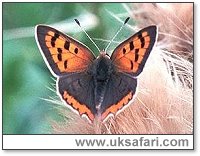
|

|
|
 Sent
to you Sent
to you
by e-mail
|
|
Simply
enter your details and hit the send button
more
info |
|


Click Here

Links
Advertise
Terms of Use
Contributors
About Us
Contact Us
|
 |
Go back
 | Bookmark
| Bookmark
 | Print Page
| Print Page  | E-Mail Us
| E-Mail Us 
 

Photo: G. Bradley
|
|
UK
Safari Tip:
Need help identifying butterflies? Checkout the ID chart in the Nature
Shop - click here
|
|
Latin name: Lycaena phlaeus
Size: Wingspan approximately 25mms.
Distribution: Found throughout the UK, but less common in Scotland.
Months seen: May to October.
Habitat: Sandy heathland and woodland edges.
Food: Nectar.
Special features: The small copper is named after its bright copper coloured forewings, which are dotted with black spots and have a black border.
The Small Copper is a fast flying butterfly, and by daytime is almost constantly on the move. Even when feeding, it rests with its wings half open (as above) ready for a lightning fast take off. Should another insect enter its air space, the small copper will swiftly drive it away.
These butterflies prefer sandy heathland, where their caterpillars can feed on their favourite food plant - sheep's sorrel. The bright green caterpillars are covered with tiny hairs, and when viewed from above, their legs and head cannot be seen, so they just look like a part of the leaf they are eating.
In a good summer, the adults can produce three broods. The first in May, the second in August and a third as late as October.
This is the last remaining copper butterfly in Britain since the Large Copper became extinct in the mid 1800's. Attempts to re-introduce the large copper, so far, have been unsuccessful. Experts have yet to determine the exact formula for their survival here.

UK Safari Butterfly Section
|
 |

|